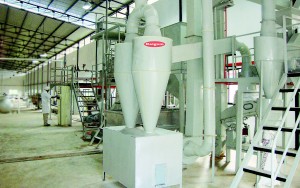‘Deveni Batha’ – the new economic and cultural revolution
The consumption of rice goes back to the very beginning of Sri Lankan history and civilization. Until foreign forces invaded this fair isle, Sri Lanka (then Ceylon) was a nation second to none because it was self sufficient in the staple food – rice.
“Rice was not only our staple food but was also the base for short-eats and sweetmeats. Fed and nourished by this wonder food- rice, our ancestors accomplished feats that were the wonder of the rest of the world,” says Dr Ravi Liyanage, Chairman/CEO Raigam Group settling down to explain to the Business Times his ethos in launching Raigam’s latest product – Rice Noodles.
He argues that with foreign market forces’ penetrating the island, imported rice in place of the country’s own, wheat flour and milk-powder, etc, was introduced.
Deveni Batha
Raigam “Deveni Batha” comes out as a substitute for rice made out of 100 per cent rice, he adds, noting that it’s an easy to prepare rice noodles, containing all the goodness of rice. “This is why it was named “Deveni Batha”,” he smiles.

View of the factory
“Although some countries had the technical know-how to manufacture rice noodles from their sticky varieties of rice, this technology was not suitable for the varieties of rice grown here in Sri Lanka.” But the research and development team of Raigam did not lose heart. Dr Liyanage says that they built a manufacturing plant with all of the modern technology. “For this some Rs. 300 million had to be invested. Situated in Homagama this facility has an intake capacity of 5000 metric tonnes per annum,” Dr Liyanage says, adding that it is envisaged to double this capacity in 2013.
Allowing for customer preference, Raigam is introducing Deveni Batha to the market in three varieties called White Kekulu Flour, Rose Kekulu Flour and Red Kekulu Flour. Dr Liyanage says that now rice production in Sri Lanka is around 4.8 million metric tonnes and this industry sustains about 880,000 farmer families. “By changing the consumer preference to noodles made from 100 per cent rice in place of wheat flour products, locally grown rice, will be made the main raw material for the preparation of our Deveni Batha,” he says, adding that this initiative will command a stable price for rice. Getting the general public used to eating rice-flour noodles in place of more familiar wheat flour noodles will substantially reduce the import of wheat flour thereby saving approximately Rs. 925 million in foreign exchange, he adds.
“Wheat flour became so popular with the public not only because of the government subsidies but also because you could make various food products of different flavours and tastes though they are not healthy and also its ease of use,” he says. Wheat flour producing countries developed bakery products through much research, he says, noting that in place of out-dated wood burning ovens, quick, electric ovens and mixing equipment were introduced. “It is due to this dedication that customer-captivating bakery products of various shapes and flavours are possible,” he opines. Noting that in the recent times people have turned to consume rice over and above bread and other products made out of wheat flour after realizing the risk of diabetes from continued consumption of wheat flour products is an important factor, according to Dr. Liyanage.
He commends the endeavours and efforts of the doctors and government officials in encouraging the consumption of rice in recent times. “As the average person cannot afford to buy bread made of wheat flour at its actual imported price, the government had to subsidize the sale of wheat flour to the importer which translates into the spending millions in foreign exchange.”
Gluten
“Although we consume rice in the form of string-hoppers, hoppers and pittu, we consume rice mainly as a plate of boiled rice,” Dr. Liyanage says, noting that to popularize the consumption of rice as a grain as compared to wheat, making as many different products as possible from rice flour, techniques to facilitate the manufacture of rice based products, etc., have to be introduced.
“Bakery products manufacturers must be encouraged to treat rice and rice flour as a very positive and viable raw material.” The ease of manufacturing food products using wheat flour is due to the sticky component Gluten present in wheat flour, he says, noting that this is why glue and “paappa” can be made from wheat flour, but Gluten is not present in rice flour in the same amounts.
“So this is the challenge when making bakery products from rice flour,” he says, noting that to overcome this it’s best to use better and improved manufacturing techniques. Government and food products manufacturers have to undertake continued research and development work, studying the techniques of high rice-consuming countries like Thailand, China, Japan and manufacturing different food items using rice flour through a manufacturing process adapted to suit the local consumer, he says. “This is how we can defeat the wheat flour mafia.”
He also says that a main reason for diabetes, a major health hazard Sri Lankans are facing today is due to the consumption of wheat flour. “This is why Deveni Batha now offers an opportunity to continue one’s consumption pattern and enjoy their favourite noodles preparation by eating rice-flour food products in place of wheat flour.”
Follow @timesonlinelk
comments powered by Disqus





















